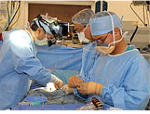


Disclaimer Privacy Policy
Copyright (c) 2021 Bicuspid Aortic Foundation, All Rights Reserved


Creating a Climate of Hope, an Atmosphere of Caring, and Information for All

Advancements
Life-Saving Treatment
Currently, there is no "cure" for thoracic aortic disease once there is degeneration of the tissue. Once present, regardless of the underlying cause, medical and surgical treatment options are available. Aortic surgery has advanced significantly, over a period of about three decades, saving many lives.
Thoracic Aortic Disease - Open Aortic Surgery
Surgery for Aortic Root, Ascending Aorta, and Aortic Valve
Button Bentall Technique
When the aortic valve, entire aortic root, and ascending aorta must all be replaced, a
technique called the Button Bentall is currently available.
Because the root is being removed, the arteries that branch off the root and provide blood to
the heart (coronary arteries) need to be sewn to the new aorta, the Dacron graft. The
"buttons" are the circles of aortic tissue that were left around the openings of these coronary
arteries. The coronary arteries are attached to the Dacron aortic graft by sewing these
buttons of aortic tissue to it.
The aortic valve is typically replaced either with a biological valve or a mechanical valve. The
original Bentall technique used a mechanical valve. When the new aortic valve is made of
biological tissue, this is called a Bio Bentall procedure.
If the aortic valve is appropriate for repair, the entire aortic root is removed and is replaced
with a Dacron graft, leaving a small rim of aortic tissue attached to the aortic valve. The
coronary arteries are re-attached to the side of the Dacron graft (aortic root remodeling
technique).
Aortic Root Remodeling
An alternative to the button bentall is to “remodel” the aortic root. This allows the coronary
arteries to remain attached to the root, but other areas are removed and replaced with the
Dacron graft which has been custom fit to the remaining root.
Removal of Entire Ascending Aorta
The majority of aortic surgeons emphasize the importance of removing the entire ascending
aorta, all the way to the beginning of the arch. When all of the ascending aortic tissue is
removed, it cannot develop another aneurysm later. In order to do this safely, the aortic arch
is left open and sewn to the Dacron graft without use of an aortic clamp (open anastomsis).
This technique is done safely under total circulatory arrest and profound hypothermia (TCA),
preferably in less than 40 minutes.
During surgery on the ascending aorta, the diseased, aneurysmal tissue is completely
removed. Earlier techniques kept the aneurysmal aortic tissue, and it was wrapped around
the Dacron graft (inclusion technique). This technique has almost disappeared over time due
to a higher incidence of pseudoaneurysm formation at the suture line. Therefore, this is no
longer considered a desirable surgical approach.
In summary, in the majority of these cases:
• the ascending aorta is removed all the way to the base of the innominate artery
• total circulatory arrest is used
• the aortic valve may be left as is, repaired, or replaced.


- Aorta
- BAV and Other Heart Valves
- Blood Pressure
- Exercise/Weight Lifting
- Featured Papers
- Guidelines
- Familial TAAD
- History
- Honoring Dr. M.E. Abbott
- Pictures (graphic content)
- Pictures Valvular Strand, Aneurysm (graphic)
- Prosthetic Heart Valves
- Scientific Awards
- Spotlight on Research - Coming Soon
- Video (graphic content)
































